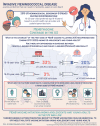Meningococcal serogroup B vaccination series initiation in the United States: A real-world claims data analysis
- PMID: 36715008
- PMCID: PMC9980443
- DOI: 10.1080/21645515.2023.2165382
Meningococcal serogroup B vaccination series initiation in the United States: A real-world claims data analysis
Abstract
In the United States (US), meningococcal serogroup B (MenB) vaccination has been recommended for 16-23-year-olds (preferably 16-18 years) based on shared clinical decision-making since 2015. MenB vaccine coverage (≥1 dose) by age 17 years has been reported, but initiation at older ages and by insurance type is unknown. In this retrospective cohort study, MarketScan claims data were analyzed to assess MenB vaccine series initiation (i.e. receipt of a first dose) during 2017-2020 among US commercially insured and Medicaid-covered individuals aged 16-18 and 19-23 years. Kaplan-Meier curves were generated to estimate series initiation at various times from index (latest of 1/1/2017 or 16th/19th birthday, depending on the cohort). Multivariable analyses were conducted to identify factors associated with series initiation. Among 1,450,354 Commercial and 1,140,977 Medicaid 16-18-year-olds, MenB vaccine series initiation rates within 3 years of each person's first eligibility were estimated to be 33% and 20%, respectively; among 1,857,628 Commercial and 747,483 Medicaid 19-23-year-olds, 3% and 1%, respectively. Factors identified to be significantly associated with increased likelihood of initiating a MenB vaccine series included co-administration of meningococcal serogroups ACWY (MenACWY) vaccine, younger age, female sex, nonwhite race (Medicaid only), New England or Middle Atlantic location (Commercial only), urban residence, and previous influenza vaccination. MenB vaccine series initiation among the studied US adolescents and young adults was low. There is a need for continued efforts to better understand barriers to the uptake of vaccines that are recommended based on shared clinical decision-making.
Keywords: MenB-4C; MenB-FHbp; Meningococcal serogroup B; adolescents; vaccination.
Conflict of interest statement
ERP is employed by Merative (IBM Watson Health at the time the study was conducted), and NMZ and LCM were employed by IBM Watson Health at the time of the study conduct and/or manuscript development. Merative (IBM Watson Health at the time the study was conducted) received funding via a contractual agreement with GSK to perform the work contributing to this research. NMZ is now employed by GSK. PN and PG were employed by GSK at the time of the study conduct and hold shares in GSK. PN is now employed by and holds shares in Dynavax. PN was employed by Moderna in the meantime and holds shares in Moderna. PG is now employed by and holds shares in Moderna. NC is employed by and holds shares in GSK. The authors declare no other financial and non-financial relationships and activities.
Figures



References
-
- Centers for Disease Control and Prevention (CDC) . Meningococcal disease. Surveillance. Atlanta (GA): National Center for Immunization and Respiratory Diseases; 2022. Feb 7. [accessed 2022 Mar 2]. https://www.cdc.gov/meningococcal/surveillance/index.html.
-
- Centers for Disease Control and Prevention (CDC) . Enhanced meningococcal disease surveillance report. Atlanta (GA): National Center for Immunization and Respiratory Diseases; 2019. [accessed 2021 Dec 15]. https://www.cdc.gov/meningococcal/downloads/NCIRD-EMS-Report-2019.pdf.
-
- MacNeil JR, Rubin L, Folaranmi T, Ortega-Sanchez IR, Patel M, Martin SW. Use of serogroup B meningococcal vaccines in adolescents and young adults: recommendations of the Advisory Committee on Immunization Practices, 2015. MMWR Morb Mortal Wkly Rep. 2015;64(41):1171–76. doi:10.15585/mmwr.mm6441a3. PMID: 26492381. - DOI - PubMed
Publication types
MeSH terms
Substances
LinkOut - more resources
Full Text Sources
Other Literature Sources
Medical
